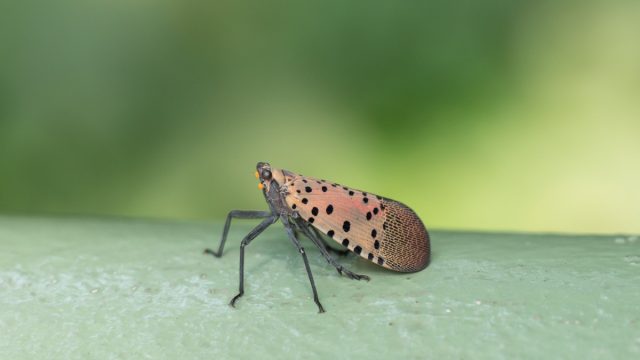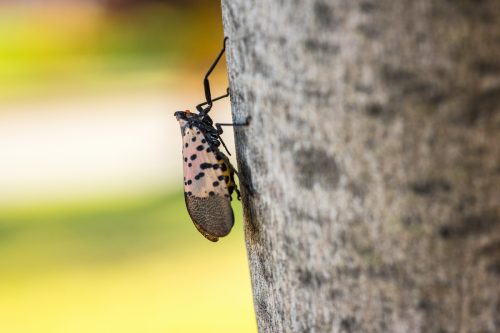If You See This Bug, Squash It Immediately, Officials Warn
Letting this insect live could end up costing some states millions of dollars.

When you see a bug out in nature—and not in the privacy of your home—experts would generally encourage you to leave it alone. Usually, bugs aren't harming anyone when they're outside, and they're often an important part of the ecosystem. There's one bug, however, that's taking over multiple states in the U.S., and it poses a significant threat to the economy. Officials across the country have advised that if you see this bug, you squash it immediately. Read on to find out which insect you should keep an eye out for.
RELATED: If You See This Spider in Your Home, Don't Step on It, Experts Warn.
If you see a spotted lanternfly, squash it immediately.

Officials in states that have been invaded by spotted lanternflies are not mincing words: They want you to kill any of these bugs that you see. Visually appealing spotted lanternflies—with light brown or scarlet wings and black spots—may look innocent, but experts warn that they could cost some states millions of dollars. Since these bugs can't fly too far, they hitch a ride on anything they can, including you, your car, or your bag.
"I can't think of something they don't lay their eggs on—cloth, metal, furniture, sides of buildings, and of course trees," Ronnit Bendavid-Val, the director of horticulture at the Brooklyn Botanic Garden, told The New York Times. Since there are no natural predators that feed on spotted lanternflies, and organic pesticides aren't enough to take them down, officials say we must do it ourselves. If you see one, "squish it," Bendavid-Val said. "That's the message." The U.S. Department of Agriculture (USDA) agrees that you should kill this bug.
RELATED: If You See This Bug, Never Touch It Without Gloves & a Mask, Experts Warn.
Spotted lanternflies can cost some states millions of dollars and thousands of jobs.

If you like wine, apples, and access to lumber, you should take your duty of killing spotted lanternflies seriously. According to the USDA, these bugs pose a threat to over a dozen essential crops, including almonds, hops, plums, apricots, and six different trees. Spotted lanternflies have the greatest potential to "seriously impact the country's grape, orchard, and logging industries" in particular.
According to Penn State Extension, if the spotted lanternfly population continues to go uncontrolled, the bugs could cost Pennsylvania at least $324 million a year and more than 2,800 jobs. And that's not the only state affected by this insect.
There are nine states dealing with spotted lanternflies.

Spotted lanternflies have been reported in nine states so far: Connecticut, Delaware, Maryland, New Jersey, New York, Ohio, Pennsylvania, Virginia, and West Virginia. Pennsylvania has seen the most significant amount of these bugs, likely because that's where the spotted lanternfly was first reported in the U.S., back in 2014. Officials in the state have gone so far as to issue a Spotted Lanternfly Order of Quarantine and Treatment. This order allows officials to impose fines and potentially criminal penalties on anyone who intentionally moves a spotted lanternfly.
The bugs have recently made their way in droves to New York, which could prove especially problematic, since spotted lanternflies could decimate the many vineyards upstate and on Long Island. One resident, Damian Biollo, told The New York Times that he was able to kill 76 in one day, 40 within the span of a few minutes, because they were everywhere.
RELATED: For more up-to-date information, sign up for our daily newsletter.
Check your vehicles for spotted lanternflies before driving.

Beyond squashing the bug, there are a few more actions you can take to help prevent the spread of this invasive species. The USDA urges you to check your vehicle for the hitchhiking bugs or egg sacs to make sure you're not accidentally transporting them. If you see an egg sac, scrape it "into a plastic bag containing hand sanitizer or rubbing alcohol to kill them," per the USDA.
When you park, ensure that your windows are closed so the bug doesn't hop inside for a ride. Additionally, report any sightings of the bug to local authorities listed on the USDA site.
RELATED: If You See This Bug, Call Local Officials Immediately, Experts Warn.





















